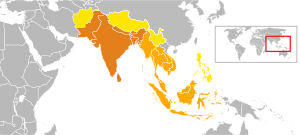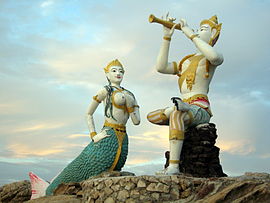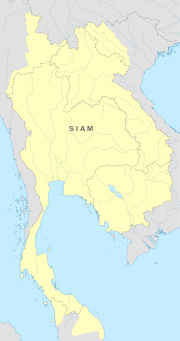
The Ramakien is one of Thailand's national epics. It is a Ramayana. Ramakien is an important part of the Thai literary canon.

Phra Sunthorn Vohara (Phu) (Thai: พระสุนทรโวหาร (ภู่), RTGS: Phra Sunthonwohan (Phu), pronounced[pʰá.sǔn.tʰɔ̄ːn.woː.hǎːn.pʰûː]; 26 June 1786 – 1855), known as Sunthorn Phu (Thai: สุนทรภู่, RTGS: Sunthonphu, pronounced[sǔn.tʰɔ̄ːn.pʰûː]), is Thailand's best-known royal poet. He wrote during the Rattanakosin period.

Phra Bat Somdet Phra Phutthaloetla Naphalai, personal name Chim, also styled as Rama II, was the second monarch of Siam under the Chakri dynasty, ruling from 1809 to 1824. In 1809, Itsarasunthon succeeded his father Rama I, the founder of Chakri dynasty, as Loetlanaphalai the King of Siam. His reign was largely peaceful, devoid of major conflicts. His reign was known as the "Golden Age of Rattanakosin Literature" as Loetlanaphalai was patron to a number of poets in his court and the King himself was a renowned poet and artist. The most notable poet in his employ was the illustrious Sunthorn Phu, the author of Phra Aphai Mani. The rapid growth of the number of his descendants was outstanding: he is believed to have had over 240 grandchildren.
Poetry has been featured extensively in Thai literature, and constituted the near-exclusive majority of literary works up to the early Rattanakosin period. Most of imaginative literary works in Thai, before the 19th century, were composed in poetry. Consequently, although many literary works were lost with the sack of Ayutthaya in 1767, Thailand still has a great number of epic poems or long poetic tales -- some with original stories and some with stories drawn from foreign sources. The Siamese poetical medium consists of five main forms, known as khlong, chan, kap, klon and rai; some of these developed indigenously while others were borrowed from other languages. Thai poetry dates to the Sukhothai period and flourished under Ayutthaya, during which it developed into its current forms. Though many works were lost to the Burmese conquest of Ayutthaya in 1767, sponsorship by subsequent kings helped revive the art, with new works created by many great poets, including Sunthorn Phu (1786–1855). Prose writing as a literary form was introduced as a Western import during the reign of King Mongkut (1851–68) and gradually gained popularity, though poetry saw a revival during the reign of King Vajiravudh (1910–25), who authored and sponsored both traditional poetry and the newer literary forms. Poetry's popularity as a mainstream form of literature gradually declined afterwards, although it is still written and read, and is regularly employed ceremonially.
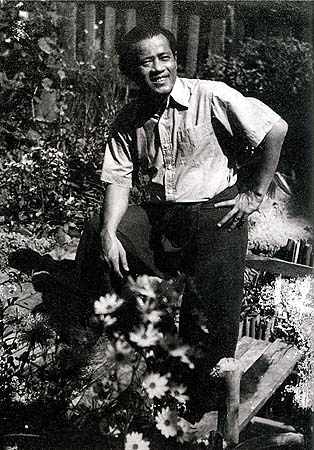
Hem Vejakorn was a Thai artist and writer. He is best known for his illustrations for the covers of 10-satang pulp novels, which have in turn influenced subsequent generations of Thai artists and illustrators, and also his ghost stories. It is estimated that he produced more than 50,000 pieces of art, including pen and pencil drawings, watercolors, posters and oil paintings. He portrayed rural life, Thai history and figures from Thai classical literature. His works have been reproduced on Thai postage stamps and featured in art galleries.

Legend of Sudsakorn is a 2006 Thai fantasy film. It is based on a story from Phra Aphai Mani, an epic poem by Sunthorn Phu. Charlie Trairat, the young male lead from Fan Chan, portrays the title character, a boy who is the son of a mermaid who is sent on a magical quest to find his father, a prince. It is a mix of live action and computer-generated imagery.

Khun Chang Khun Phaen is a long Thai epic poem which originated from a legend of Thai folklore and is one of the most notable works in Thai literature. The work's entire length is over 20,000 couplets. Khun Chang and Khun Phaen are the leading male characters, where "Khun" was a junior feudal title given for male commoners. The story recounts the adventurous and amorous struggles of the three main protagonists. Much of their relationship can be described as a love triangle. Khun Phaen and Khun Chang compete for the lovely Wanthong from childhood for over fifty years. Their stories transpire amid the larger backdrop of national events, including two wars, several abductions, a suspected revolt, an idyllic sojourn in the forest, two court cases, trial by ordeal, jail, and treachery. Ultimately the King of Ayutthaya condemns Wanthong to death for failing to choose between the two men.
"Thai Prophecy Verse", also the "Long Song Prophecy for Ayutthaya" is a poem forecasting the future of Thailand. It was composed in a similar vein to Maha Supina Jataka, which features the reply of Buddha to King Pasenadi of Kosala about the King's sixteen-fold dream.

Apaimanee Saga is a Thai comic series written and illustrated by Supot A. It was originally serialized in Thailand in NED Comics' magazine Boom. The story was adapted from the Thai epic poem Phra Aphai Mani by Sunthorn Phu, a legendary poet.

Phra Aphai Mani is a 48,700-line epic poem composed by Thai poet Sunthorn Phu, who is known as "the Bard of Rattanakosin". It is considered to be one of Thailand's national epics. With 48,686 couplets, it is listed as the longest Thai single poem. Suthorn Phu started working on this epic fantasy in 1822 and finished it in 1844; it took 22 years. It is also one of the most well-known Thai folklores that has been heavily adapted into films and comics. The main protagonists are Prince Aphai Mani, the mermaid, and the Pisue Samutra; a female ogress who can transmute herself into a beautiful girl.

Thawathotsamat is a poem of 1,042 lines in Thai, probably composed in the late fifteenth century CE. The title is a Thai adaptation of the Pali-Sanskrit words dvā dasa māsa, two ten months. The male speaker laments over a lost lover through the course of one year, drawing on the seasonal weather for similes of his emotions. Both the speaker and beloved are addressed with royal forms. A late verse declares that the poem was written by a "young-king" with the help of three court poets. The work has sometimes been mistakenly classified as a treatise on Siamese royal ceremonies. The work is less studied and less well-known than other early works of Thai literature, partly because of the obscurity of its archaic language, and partly because of conservative concerns over its erotic passages. A new annotated Thai edition appeared in 2017.
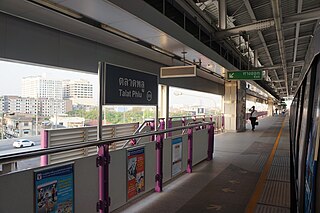
Dao Khanong is a khwaeng (sub-district) of Thon Buri district, Bangkok's Thonburi side. It is also the name of the surrounding area.
Thammathibet Chaiyachet Suriyawong, the Prince Senaphithak or Prince Narathibet, also known as Prince Kung/ Chao Fa Kung, was Viceroy of the front palace of the Kingdom of Ayutthaya, from 1732/33 but he is more well-known as one of the most prominent poets in Thai literature. He also created the music for the Royal Barge Procession.

Si Prat is a legendary Thai poet believed to have served King Narai during the 17th century. According to traditional tellings, he was subsequently banished to South Thailand as a result of his personal indiscretions and executed after having an affair with the wife of a provincial governor.

Kamsuan Samut, translated into English as Ocean Lament, is a poem of around 520 lines in Thai in the khlong si meter. It concerns a man who leaves the old Siamese capital of Ayutthaya and travels in a small boat down the Chao Phraya River and out into the Gulf of Thailand. Along the way he laments over his parting from a lover who he calls Si Chulalak, perhaps the name of a royal consort. The reason for his flight and his destination are not explained. The extant poem ends abruptly, although there might have been a longer variant. The work is considered a precursor or pioneer of the nirat genre of Thai poetry. The authorship, dating and original title of the poem are unknown and have been subjects of academic debate. The poem was once attributed to a court poet named Si Prat in the reign of King Narai, but this is now considered doubtful. The poem was first printed in 1950. It is considered a gem of old Thai literature because of the intensity of the poet's expression of loss and the elegance of the verse.

Lilit Phra Lo is a narrative poem of around 3,870 lines in Thai. Lilit is a poetic form; Phra is a prefix used for royalty and monks; Lo is the personal name of the hero, sometimes transcribed as Lor or Law. Date and authorship are unknown but the work was probably composed in the late fifteenth or early sixteenth century CE and counts among the five earliest works of Thai literature. The plot is a courtly romance that ends with a tragic massacre and political reconciliation. The work has been criticized for portraying feudal indulgence. The story has been repeatedly reworked by prominent novelists and film-makers, often adapting the plot to conform to modern values.
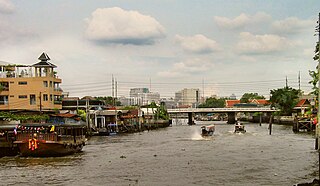
Khlong Bangkok Noi is a khlong in Bangkok; its name is the origin of the name Bangkok Noi District. The mouth of Khlong Bangkok Noi is located beside Siriraj Piyamaharajkarun Hospital (SiPH) and the former Bangkok Noi railway station. The current flows north through many historical and cultural landmarks, such as Ansorissunnah Royal Mosque, National Museum of Royal Barges, Wat Suwannaram, Thon Buri railway station, Wat Amarintharam, and Wat Si Sudaram, a Thai temple known as the place where the poet Sunthorn Phu studied in his childhood, as well as Wat Bang Oi Chang in Nonthaburi Province, etc. The canal terminates at the confluence with Khlong Om Non and Khlong Bang Yai at the Old Bang Yai Market in Bang Yai District, Nonthaburi Province, along the way, it is also connected to many canals, such as Khlong Chak Phra, Khlong Maha Sawat, Khlong Bang Kruai.

Khlong Samrong is a khlong (canal) in central Thailand, regarded as the main watercourse of Samut Prakan Province.
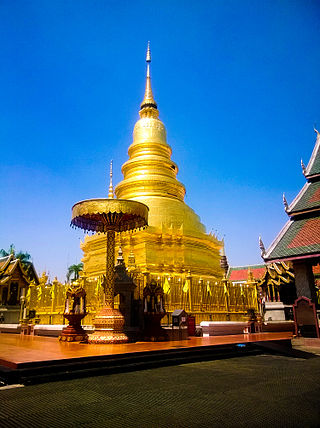
Nirat Hariphunchai is an old poem of around 720 lines, originally composed in Northern Thai language. Nirat, derived from a Sanskrit word meaning “without”, is a genre of Thai poetry that involves travel and love-longing for a separated beloved. Hariphunchai was an ancient kingdom, centered at Lamphun, incorporated into the Lan Na kingdom by Mangrai in the late 13th century. The poem recounts a journey from Chiang Mai to Lamphun to venerate the Buddhist reliquary, Wat Phra That Hariphunchai, with visits to around twenty temples and shrines along the way. During the journey, the author laments his separation from his beloved Si Thip. The journey takes two or three days. The poem ends at a festival in the reliquary, attended by a queen and her son. The original may date to 1517/18 CE. The poem was little appreciated until recently owing to the difficulty of the old language.

